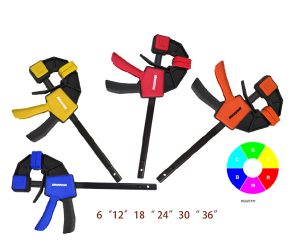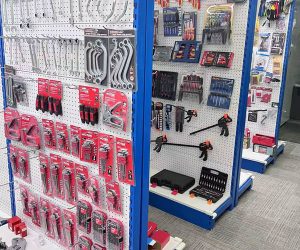Spring clamps are versatile tools that find their place in a variety of applications. Whether you’re a DIY enthusiast working on home improvement tasks, a professional carpenter, or even a hobbyist engaged in crafting, spring clamps are essential for holding materials securely while you work. In this article, we’ll explore the top 10 ways to use a spring clamp, showing how it can be applied in both DIY projects and professional environments. By the end, you’ll have a clear understanding of when and how to use spring clamps to make your work more efficient and precise.
1. What Is a Spring Clamp?
A spring clamp is a tool designed to hold materials together using the tension of a spring. It typically has two arms with a spring mechanism that provides constant pressure to keep the jaws closed. The handles are squeezed to open the clamp, and once released, the tension of the spring closes the jaws, holding the materials in place. But here’s the kicker: while it seems like a simple tool, the wide variety of spring clamps available makes it adaptable to nearly any project.
There are several types of spring clamps, varying in size, shape, and strength. The most common types include mini spring clamps, which are ideal for small tasks like crafting, and larger versions used for woodworking or construction. Understanding the different types of spring clamps will help you choose the right one for your project. For instance, a smaller clamp might be perfect for holding two pieces of fabric together while sewing, while a larger clamp is ideal for holding two wooden boards in place during glueing.
Spring clamps are not only versatile, but they are also easy to use. Their spring-loaded design makes them user-friendly for both professionals and beginners. Whether you’re looking to secure materials temporarily or need extra hands while working on a project, a spring clamp is a reliable choice.
| Type of Spring Clamp | Ideal Usage | Key Features |
|---|---|---|
| Mini Spring Clamp | Small DIY tasks, crafting | Compact, lightweight |
| Large Spring Clamp | Woodworking, construction | Strong grip, larger jaw capacity |
| Plastic Coated Spring Clamp | Delicate materials | Protective coating to prevent damage |
2. Why Should You Use a Spring Clamp?
Spring clamps are highly regarded for their simplicity and ease of use. What’s the real story behind their popularity? These clamps are not just easy to use; they are also highly efficient, versatile, and affordable. One of the main reasons people prefer spring clamps is that they save time. Unlike traditional clamps, spring clamps require no setup or adjustment — just squeeze, hold, and you’re done.
In a DIY setting, using a spring clamp is an excellent way to quickly hold materials together while you work on other aspects of the project. Whether you’re gluing, nailing, or cutting, a spring clamp can secure your materials in place, so you don’t need to worry about them shifting. For example, if you are working on a woodworking project, using a spring clamp to hold pieces together while the glue dries can improve the accuracy of your work and prevent errors caused by shifting materials.
But here’s the kicker: spring clamps are also incredibly affordable. You don’t need to break the bank to get a set of high-quality spring clamps. They are available at most hardware stores, and you can purchase them in bulk without spending a lot of money. This cost-effectiveness makes them an attractive option for both hobbyists and professionals looking to get reliable tools on a budget.
| Key Benefits of Spring Clamps | Description |
|---|---|
| Ease of Use | Quick setup with no adjustments needed |
| Versatility | Suitable for various materials and projects |
| Cost-Effective | Affordable for both casual and professional use |
3. How Do Spring Clamps Work?
Spring clamps operate by using the tension of a spring to apply pressure to the jaws, which hold the materials in place. This mechanism is quite straightforward. As you squeeze the handles of the spring clamp, the jaws open, and when you release the handles, the spring closes them, gripping the materials securely. Ready for the good part? The pressure applied by the spring ensures a firm hold, which makes these clamps incredibly useful for many different types of work.
Spring clamps are typically designed with a mechanism that allows you to exert pressure with minimal effort. The tension from the spring ensures that the clamp holds its position even under moderate pressure. For example, if you’re using a spring clamp to hold two wooden pieces together, you can apply enough force to secure them temporarily while glue dries or while you work on another aspect of the project.
While using a spring clamp, it’s essential to ensure that you’re applying the right amount of pressure. Too little pressure, and the clamp won’t hold the materials securely. Too much pressure, and you risk damaging the materials. Therefore, selecting the correct size spring clamp for your task is crucial.
| Clamp Size | Pressure Applied | Best for |
|---|---|---|
| Small | Light pressure | Small DIY tasks, crafting |
| Medium | Moderate pressure | Woodworking, furniture assembly |
| Large | Heavy pressure | Metalworking, large construction projects |
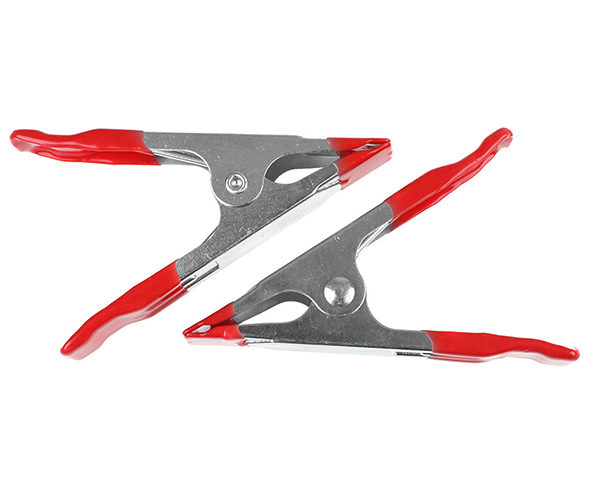
4. What Are the Most Common Uses of Spring Clamps in DIY Projects?
Spring clamps are a staple tool for DIY enthusiasts. Whether you’re working on a home improvement project or a craft, these clamps provide an easy way to hold things together without the need for extra hands. Here’s the real story: spring clamps are ideal for temporary holding, which makes them perfect for DIY tasks where you need to secure items while working on other parts of the project.
One of the most common uses for spring clamps in DIY projects is in woodworking. When gluing wooden pieces together, it’s essential to hold them in place while the glue dries. A spring clamp provides a quick and efficient way to apply pressure to the pieces, keeping them secure until the glue sets. Similarly, if you are working on a painting project, spring clamps can be used to hold a canvas or wooden frame steady while you paint.
In addition to woodworking, spring clamps are also useful for a wide range of craft projects. Whether you’re sewing, quilting, or doing other delicate work, these clamps can hold fabric pieces together without causing any damage. And because they come in different sizes, you can choose the right clamp for your specific task.
| DIY Task | Common Use | Spring Clamp Benefit |
|---|---|---|
| Woodworking | Gluing pieces together | Quick, secure hold while drying |
| Painting | Holding materials steady | Prevents movement during work |
| Crafting | Holding fabric or paper | Gentle hold without damage |
5. How Are Spring Clamps Used in Professional Work?
While spring clamps are most commonly associated with DIY projects, they also have a place in professional work. For professionals, the use of spring clamps can speed up projects, reduce manual effort, and ensure precision. But here’s where it gets interesting: spring clamps are highly valued in fields such as carpentry, construction, and even metalworking for their reliability and versatility.
In carpentry, spring clamps are used to hold pieces of wood together while the glue sets, much like in DIY work. However, the advantage for professionals is that the clamps allow them to work faster and more efficiently, especially in large projects that require multiple pieces to be held together at once. Similarly, in construction, these clamps are used to secure materials temporarily, freeing up workers to focus on other tasks.
Spring clamps are also utilized in auto repair shops for various tasks. From holding trim pieces while they are attached to securing upholstery fabric, these clamps provide a temporary but firm hold. They are also used in metalworking for shaping and bending metal pieces.
| Professional Use | Industry | Benefit |
|---|---|---|
| Carpentry | Woodworking | Quick and secure material holding |
| Construction | Building projects | Efficient temporary clamping |
| Auto Repair | Upholstery, trim work | Temporary hold for precision tasks |
6. How Do Spring Clamps Help in Woodworking Projects?
Woodworking projects require precise clamping, especially when working with materials like wood, which can shift easily. Spring clamps are an excellent choice for holding wood in place while glue dries, nails are driven, or cuts are made. What’s the deal with spring clamps in woodworking? They are great for quick, temporary clamping without the need for complex adjustments.
In woodworking, one of the most common uses for spring clamps is securing pieces of wood together during glue-up. The tension from the spring ensures that the pieces stay aligned while the glue bonds. But there’s more to it: spring clamps can also be used to hold wood in place while sanding or painting. When working with larger projects, spring clamps make it easier to manage multiple parts at once without wasting time adjusting clamps.
These clamps come in various sizes, making them perfect for small tasks such as holding dowels or large tasks like holding the edges of a tabletop in place. Whether you’re building furniture or simply completing a repair, spring clamps are a reliable and affordable option.
| Woodworking Task | Use of Spring Clamp | Key Benefit |
|---|---|---|
| Gluing | Holding wood pieces together | Quick, easy clamping during glue-up |
| Sanding | Securing wood during sanding | Prevents shifting during sanding process |
| Painting | Holding wood for painting | Keeps wood steady for precise work |
7. What Is the Role of Spring Clamps in Metalworking?
Metalworking often requires precision and secure holding of materials, and spring clamps play a vital role in this process. But here’s the kicker: spring clamps are essential for tasks like welding, cutting, and shaping metal, where you need both hands free to focus on the task at hand.
In welding, spring clamps are used to temporarily hold metal parts in place before welding them permanently. They provide just the right amount of pressure to hold parts together without damaging the metal. Similarly, when cutting metal or bending it, spring clamps can hold the material securely in place, allowing for more accurate cuts and bends.
Another use for spring clamps in metalworking is during polishing and finishing. By holding parts in place, these clamps ensure that you can focus on the finer details of the finishing process without worrying about the material shifting.
| Metalworking Task | Use of Spring Clamp | Key Benefit |
|---|---|---|
| Welding | Holding parts together | Temporary hold for precise welding |
| Cutting | Securing metal for cuts | Keeps metal in place for accurate cutting |
| Polishing | Holding metal during finishing | Ensures materials stay steady during polishing |
8. Can Spring Clamps Be Used for Sewing and Fabric Projects?
Spring clamps are not just for woodworking and metalworking; they’re also great for fabric projects. For sewers and quilters, these clamps provide a gentle yet firm grip on fabric, making them ideal for holding pieces together without damaging the material. Ready for the good part? Spring clamps eliminate the need for pins in many cases, speeding up the process and making it easier to work with delicate fabrics.
Whether you’re quilting, hemming, or working on other sewing projects, spring clamps can hold fabric layers in place while you sew. The best part? They don’t leave holes in the fabric like pins can, which is crucial when working with fine or delicate materials.
| Fabric Project | Use of Spring Clamp | Key Benefit |
|---|---|---|
| Quilting | Holding fabric layers together | Prevents shifting, no pinholes |
| Sewing | Securing fabric while stitching | Quick, easy clamping without damage |
| Hemming | Holding hems in place | Provides secure hold during sewing |
9. How Do Spring Clamps Assist in Auto Repair and Maintenance?
In auto repair, spring clamps are useful for tasks that require temporary material holding or clamping. From upholstery to trim work, these clamps are invaluable for keeping materials in place while repairs or modifications are made. This is where it gets interesting: spring clamps offer a quick, simple solution to hold materials securely while ensuring precision in repairs.
For example, in auto upholstery, spring clamps are used to hold fabric in place while it is being sewn or attached to seats. Similarly, these clamps can be used to secure parts of trim or bodywork while other parts of the vehicle are being worked on.
| Auto Repair Task | Use of Spring Clamp | Key Benefit |
|---|---|---|
| Upholstery | Holding fabric while sewing | Quick, secure hold during work |
| Trim Work | Securing trim pieces | Prevents shifting while attaching |
10. What Are the Benefits of Using Spring Clamps for Painting and Staining?
Spring clamps are essential for many painting and staining projects. Whether you’re painting furniture, walls, or trim, these clamps are designed to hold materials steady while you work. The advantage of using spring clamps in these projects is that they provide a secure hold without damaging the material. What’s the real story here? Spring clamps help prevent smudging and stains by keeping your materials in place.
Spring clamps are particularly useful when working with small items like picture frames, wooden boards, or even outdoor furniture. They hold the piece steady, preventing it from sliding or shifting while you apply paint or stain.
| Painting Task | Use of Spring Clamp | Key Benefit |
|---|---|---|
| Furniture Painting | Holding furniture steady | Prevents shifting while painting |
| Wall Painting | Securing trim pieces | Keeps trim in place for precise work |
| Staining | Holding wood steady | Prevents sliding during staining |
11. How Do You Properly Use a Spring Clamp for Secure Clamping?
Using a spring clamp properly ensures that your materials are held securely without causing any damage. It’s all about the right pressure and position. When using a spring clamp, make sure you’re applying enough pressure to hold the materials without over-clamping, which can lead to damage.
When selecting a spring clamp, choose one that is the appropriate size for your project. For delicate materials like fabric or thin wood, use a smaller spring clamp with a softer tension. For larger projects, a bigger clamp with stronger tension may be necessary.
| Material Type | Recommended Spring Clamp | Key Considerations |
|---|---|---|
| Fabric | Small spring clamp | Soft tension to avoid damage |
| Wood | Medium/large spring clamp | Moderate pressure for secure hold |
| Metal | Large spring clamp | Strong pressure for stability |
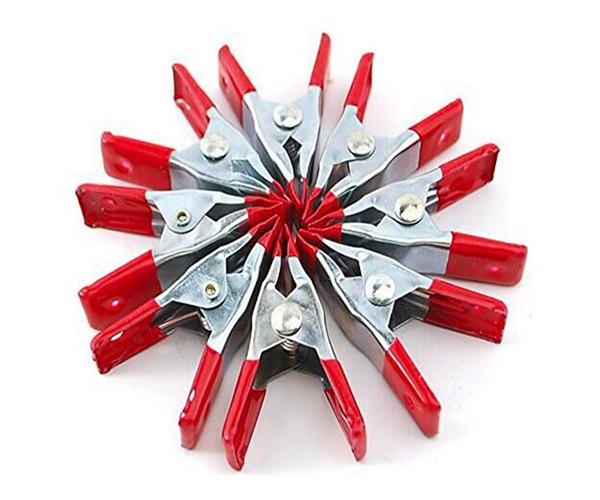
12. Are There Any Alternatives to Spring Clamps?
While spring clamps are incredibly versatile, they aren’t the only option for clamping materials. What’s the deal with alternatives? There are several other types of clamps that might be more suitable depending on the project. Here’s the catch: each clamp type has its specific advantages, so understanding when to use each one is key to choosing the right tool for your task.
For example, C-clamps are often used in woodworking and metalworking, where a more secure, adjustable hold is needed. Unlike spring clamps, C-clamps allow for greater control over the amount of pressure applied to the material, making them ideal for more heavy-duty tasks. Bar clamps, on the other hand, are larger and can hold larger pieces of material, like panels or frames, in place while you work. These clamps are ideal for larger projects where multiple pieces need to be held together simultaneously.
What’s the real story? While spring clamps are quick and easy, other clamps like bar clamps and C-clamps offer different benefits that might be better suited for certain tasks. Understanding the specific needs of your project will help you make the best choice.
| Clamp Type | Ideal Use | Key Features |
|---|---|---|
| C-Clamps | Heavy-duty work, metalworking | Adjustable pressure, secure hold |
| Bar Clamps | Large projects, framing | Greater clamping range for large materials |
| Spring Clamps | Small tasks, quick clamping | Easy to use, quick setup |
13. How Do You Maintain and Care for Spring Clamps?
Taking care of your spring clamps ensures that they continue to function well and last longer. Ready for the good part? Proper maintenance can extend the life of your clamps and help prevent malfunctions or damage. The most important thing is to keep the springs clean and lubricated to prevent rust and corrosion. Over time, dirt and debris can accumulate, which can prevent the clamp from working smoothly.
One of the best ways to maintain spring clamps is to clean them after every use, especially if you’ve been working with glue, paint, or other sticky substances. Use a soft cloth to wipe off any residue and a small brush to remove any dirt from the spring mechanism. Periodically apply a light oil or lubricant to the spring to keep it functioning smoothly. What’s the kicker? This will also prevent the clamps from becoming rusty and stiff over time.
Another maintenance tip is to check the clamp for any signs of wear. If you notice that the jaws aren’t closing properly or that the spring isn’t providing enough tension, it might be time to replace the clamp or fix the spring.
| Maintenance Task | Recommended Action | Key Benefit |
|---|---|---|
| Cleaning | Wipe down after each use | Prevents buildup and ensures smooth operation |
| Lubrication | Apply light oil to springs | Prevents rust and ensures spring function |
| Inspection | Check for signs of wear | Ensures the clamp remains effective and safe |
14. What Safety Precautions Should You Take When Using a Spring Clamp?
Safety is always a priority when working with tools. But here’s the kicker: using spring clamps incorrectly can lead to accidents. When using a spring clamp, always ensure that your hands are clear of the jaws when releasing the clamp. The tension in the spring can cause the jaws to snap shut quickly, potentially causing injury if your fingers are in the way.
Also, be cautious when applying pressure. Over-tightening a spring clamp can damage the material you’re working with, and in some cases, it can cause the clamp to break. Always ensure that you’re using the appropriate size clamp for the material you’re working with. For instance, using a small spring clamp on a large piece of wood might not provide enough pressure to hold it securely, which can lead to slipping or shifting during the task.
What’s the real story? Properly using a spring clamp involves knowing how much pressure is enough and ensuring that the clamp is used safely. Always check your clamps for damage before each use and ensure they are in good working condition.
| Safety Tip | Action | Key Benefit |
|---|---|---|
| Hand Safety | Keep hands clear of the jaws | Prevents injury when releasing the clamp |
| Pressure Control | Don’t over-tighten clamps | Prevents damage to materials and clamp breakage |
| Inspection | Check for damage before use | Ensures safe and effective clamping |
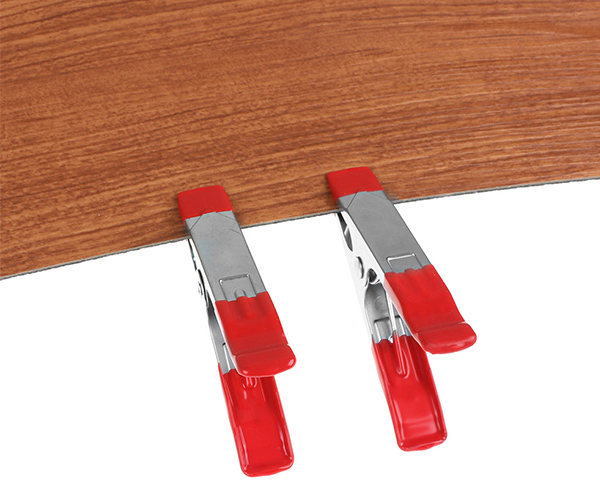
15. Where Can You Buy the Best Spring Clamps for Your Projects?
Now that you know how useful spring clamps can be, you might be wondering where to buy them. Here’s the kicker: there are many options available both online and in physical stores, but knowing where to shop can help you find high-quality clamps at a reasonable price. Ready for the good part? Some of the best spring clamps come from trusted brands that specialize in tools for both professionals and DIYers.
For a reliable selection, start by checking your local hardware store, which often carries a variety of clamps suitable for DIY projects. Big-box retailers like Home Depot and Lowe’s also offer an extensive selection of spring clamps at affordable prices. If you prefer shopping online, platforms like Amazon and eBay provide a wide range of options from trusted brands. What’s the deal with buying online? Shopping online can give you the chance to compare different models, prices, and reviews to make a more informed purchase decision.
Professional-grade spring clamps can be found at specialty tool stores or directly from tool manufacturers. Many professional brands offer bulk pricing, making it easier for businesses to purchase large quantities at a discount.
| Store Type | Where to Buy | Benefits |
|---|---|---|
| Local Hardware Store | In-person | Hands-on selection, immediate purchase |
| Online Retailers | Amazon, eBay | Convenient shopping, customer reviews |
| Specialty Tool Stores | Direct from manufacturer | High-quality, professional-grade clamps |
FAQ
Q1: What is a spring clamp?
A spring clamp is a hand tool that uses a spring mechanism to apply pressure and hold materials in place temporarily.
Q2: How does a spring clamp work?
Spring clamps apply pressure by using a spring-loaded mechanism that holds materials in place when the handles are released.
Q3: What are the most common uses of spring clamps in DIY projects?
Spring clamps are commonly used in woodworking, painting, and crafting to hold materials together temporarily while working.
Q4: Can spring clamps be used in professional work?
Yes, spring clamps are widely used in carpentry, metalworking, and auto repair due to their reliability and ease of use.
Q5: How do you maintain and care for spring clamps?
To maintain spring clamps, regularly clean them, lubricate the springs, and check for any wear or damage to ensure they continue to work effectively.


